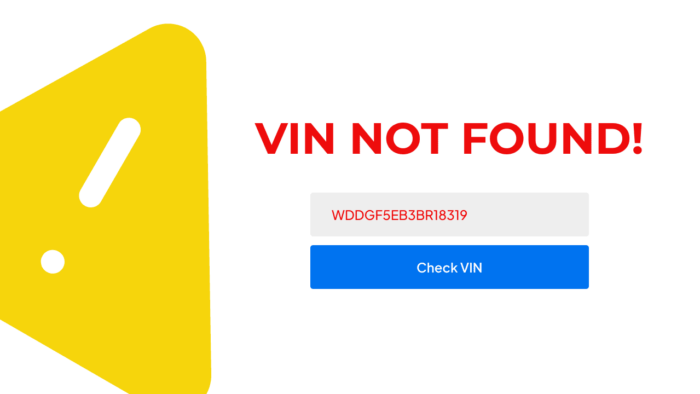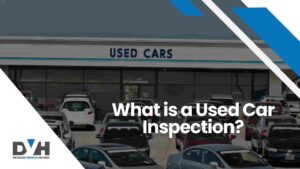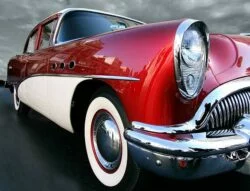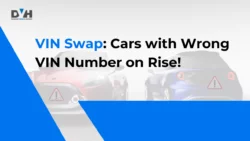When you’re in the market for a used vehicle, conducting a VIN decoder is essential to assessing its history and condition.
However, there may be times when you get the frustrating message “VIN Not Found”. It’s like hitting a roadblock when you’re about to gain crucial insights into your potential investment.
So why does this happen?
This article clearly explains why you may get the ‘VIN not found ‘message during a VIN check, registration, or at an insurance agency.
Why Do I Get the “VIN NOT FOUND” Message?
You may encounter the “VIN not found” or “invalid VIN” message in several situations, and some of these situations are:
1. Data entry errors
Sometimes, the simplest explanation is the correct one. Human error during data entry can result in an incorrect VIN inputting into the system. It could be a single typo, transposed digits, or a misinterpretation of the VIN characters.
Before panicking, double-check the VIN you are entering to ensure it matches the VIN on the vehicle’s registration documents. Check Bs, as they may look like 8s, or check if it’s a 0 instead.
2. Non-standard or incomplete VINs
While the standard VIN comprises 17 characters (digits and capital letters), there are instances where you might encounter non-standard or incomplete VINs.
Some older vehicles (classic vehicles) might have VINs with fewer characters, while custom-built or special vehicles could have VINs that deviate from the standard format. In such cases, the VIN might not be recognized by specific databases or VIN check services.
For example, Carfax, AutoCheck, and some other vehicle history providers cannot decode classic VINs (5 to 13-digit VINs) – but our VIN decoder can do that for you 😉
3. Entered VIN with invalid characters
VINs adhere to a specific format for clarity and precision. One common mistake occurs when invalid characters such as ‘I,’ ‘O’, or ‘Q’ are mistakenly included. These characters are omitted from VINs to prevent confusion between alphabetical letters and numerical digits.
If you’ve entered a VIN containing invalid characters, you need to recheck and ensure the correct characters are used to proceed accurately with the VIN check.
4. Altered or fraudulent VIN
Unfortunately, VIN fraud is a genuine concern in the automotive market. Dishonest sellers may clone or alter VINs to conceal a vehicle’s true history, such as its involvement in theft, accidents, or other illegal activities.
If a VIN check returns a “VIN Not Found” message, it could be a red flag indicating potential tampering with the vehicle’s identification number.
5. Outside of data provider coverage
Another reason you may receive the “VIN number not found” error message because the provider does not have your vehicle’s records. Not all documents are found on all providers. Some have limited databases, and others are simply not up-to-date.
Instead of panicking, know that it’s possible that the VIN might exist but hasn’t been updated in the database you’re using.
Now that we know why you may find the error message during a VIN check or insurance registration, let’s look at some solutions.
How to Solve the VIN Not Found Issue During VIN Check
Did you encounter the frustrating “VIN Not Found” message? Here are several ways to solve this problem and get the VIN check you want:
Recheck VIN entry
You can begin by checking for typos. Human error, such as typos or transposed digits, can lead to an invalid VIN entry. Ensure that you’ve accurately inputted all 17 characters of the used car VIN, avoiding common mistakes like confusing ‘I’, ‘O’, or ‘Q’ with numerical digits.
Check for physical damages
Inspect the vehicle’s VIN sticker or frame for any signs of damage. In some cases, physical wear and tear or accidents may have caused some characters in the VIN to become illegible or missing. If you find any discrepancies, consult the vehicle’s registration documents or contact the manufacturer for assistance.
Try Other VIN Check Providers
If the VIN check service you’re using fails to decode the VIN, consider trying alternative platforms. Some VIN check providers have limited access to vehicle history records compared with others.
One provider we would recommend is Detailed Vehicle History. This provider decodes all VINs regardless of VIN length, age, or vehicle type. With our unique VIN check tool, you can check the VIN of any vehicle and get detailed information in seconds. Some of the records you will gain access to are:
- Ownership records
- Theft or stolen records
- Accident records
- Title brand records
- Damage records
- Sales records
- Auction history with up to ten images (if available)
- Vehicle usage
- Odometer rollback
- Lien and loan records
- Market value
- Maintenance history
- Vehicle specifications
- Warranty status and more.
If you don’t have the VIN number, you can use a license plate lookup to obtain the necessary vehicle information.
The best part is you can use their free VIN decoding service to get vehicle specifications, car market value, and other data for free on the website and mobile app.
Read More: How To Check Car History Online
Conclusion
Understand that anyone can get the “VIN not found” or “invalid VIN” message, as no one is above errors. You may have missed one character or included the wrong one, or your data provider may not have the information you need.
Keep in mind that when this happens, there’s absolutely nothing to panic. Just try to enter the right digits, and if it still doesn’t work, use a different provider like Detailed Vehicle History. With Detailed Vehicle History, you can get a history report for your vehicle or obtain a window sticker by VIN for your vehicle as well.










